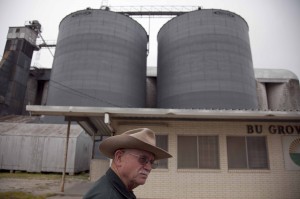Without River Water, Rice Farmers Look to Alternative Crops

Photo by Jeff Heimsath/StateImpact Texas
Rice farmers Billy Mann in Bay City, Texas.
Rice has been growing in Texas since the 1800s, but for the past two years most rice farmers in Southeast Texas along the Lower Colorado River have been cut off from their usual water supplies because of the ongoing Texas drought. It’s possible they will be cut off a third time next year, leading to the question: can rice farming continue along the Lower Colorado River?
It they are cut off again next year, rice farmers on the Lower Colorado expect to lose the crop insurance benefits that have helped sustain them through the last two years without water. Some have begun planting less water-intensive alternative crops, such as sorghum and soy beans, to generate income on farms that are otherwise in economic limbo. But in this humid, once-swampy region stretching to the Gulf Coast, some rice farmers say that growing crops other than rice is not a permanently viable solution.
That’s because the conditions that make the Lower Colorado River ideal for growing rice also make it inhospitable to other crops, according to Ron Gertson, a rice farmer who chairs the Colorado Water Issues Committee.
A thick layer of clay beneath the top soil traps irrigation water, providing a saturated environment where shallow-rooted rice plants thrive. But according to Gertson, plants with deeper roots are stunted, because their roots cannot grow beyond that impenetrable clay layer.
“You take corn, for example,” Gertson said. “If a corn plant is seven feet tall, its roots grow seven feet deep, typically. If you plant corn in our soil, those roots will go down to that hard clay and stop. It can’t go any further. As a result, the corn plant can’t get the nutrients and moisture that it needs from our shallow top soil. You will not see corn grown, even experimentally, in our soil type, because it’s just an idiotic thing to do.”
Nevertheless, some farmers on the Lower Colorado River are planting corn. According to Mike Burnside, a Matagorda County rice farmer, the area’s thick clay soil can be “busted” by a tractor-mounted tool called a subsoiler. The clay, once broken, holds water that allows the corn plants to grow well, without restricting the growth of their roots.
Gertson said the land is also not ideal for soy beans or sorghum, which are two alternative crops that some rice farmers planted this year. Soy beans can sour and grow fungus on the Gulf Coast, because tropical depressions often bring heavy rains to the area during harvest time.
But according to Burnside, who is growing soybeans in a coastal county, that problem can be avoided by harvesting the crop before mid-August—although some soy bean varieties are not ready for harvest by then. Due to the drought, Burnside’s own soy beans are “burning up” this year.
Usually, Gertson said, sorghum plants suffer from the same problem as corn–their roots, though not as deep, are restricted by clay. (Subsoilers could also address this problem.) This year, however, light summer rains have kept sorghum plants’ roots from drying out in the top soil, and “record-high” sorghum prices have made the crop an unusually attractive option.
“I would say sorghum, on a per-acre basis, is going to offer an income level of about 20 to 25 percent of rice, in a good year,” Gertson said. “Years ago, we tried sorghum. About one in six years, we could make some money on it. The other five years, we lost more money than we gained in one year.”
This year, however, was unusual. A severe drought damaged the sorghum crop in the Midwest, and sorghum prices soared. Gertson and other Texas rice farmers saw that growing sorghum would be profitable this year, even if they produced a marginal crop. However, rather than “gamble the whole farm” on a crop that does not grow well in their region, Gertson said they only planted sorghum on a small percentage of their land.
According to Dr. Ted Wilson, director of the Texas A&M AgriLife Research Center in Beaumont, the clay soils of rice farmland in the Lower Colorado River region tends to be less “flexible” than loam soils in the Midwest, which can potentially support a broader range of crops. Another economic option is converting rice farmland to pastureland—but as Gertson notes, farmers face several challenges in entering the ranching business. The ranching and farming businesses are very different, and rice farmers have already invested in expensive farming equipment. Also, local land rents are geared towards rice farming.
What will happen next year, if the region is still deep in drought, crop insurance benefits are gone, and farmers cannot yet return to growing rice? Gertson says land rents will have to be adjusted downward, tax revenue will decline, and local businesses that provide farm equipment and rice processing will continue to suffer or shut down.
Gertson does not, however, envision rice farmers leaving the Lower Colorado River. Eventually, he said, the drought will end, allowing them to resume growing rice. He hopes that water-efficient technology and new research on less water-intensive varieties of rice will make it possible to grow rice with less water. (According to a report by the LCRA, rice farmers used 367,985 acre-feet of water from the Highland Lakes in 2011 — more than three times the amount used by Austin.)
The LCRA is also working to build a reservoir downstream (at a projected cost of $206 million) that would catch and store water for rice farmers in the region and put less strain on the Highland Lakes, a vital reservoir for municipal customers like the City of Austin.
Research on different varieties of rice has been conducted for years by Texas A&M AgriLife, which receives funding for that work from the Texas Rice Research Foundation, an association of rice farmers. In 60 years, Gertson said, that research has allowed rice farmers to “increase our yield by about six-fold.”
According to Wilson, building off-channel reservoirs to store river and rainwater is another way to sustain rice farming on the Lower Colorado River.
“Rice farming is in most of these folks’ blood,” Gertson said. “I’m a fourth-generation rice producer. My son is a rice producer. It’s what we know how to do. We do it well … If and when water does became available again, there will be folks left here to utilize it for rice production.”
Holly Heinrich is a reporting intern for StateImpact Texas.
